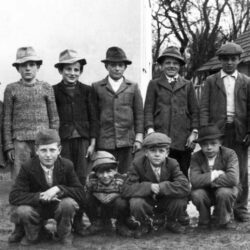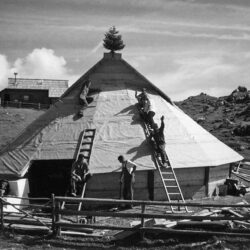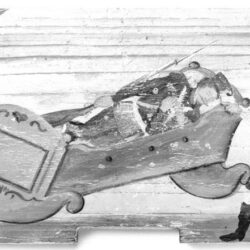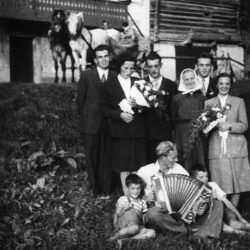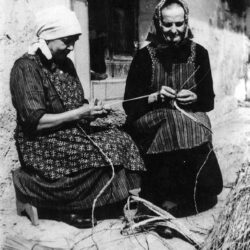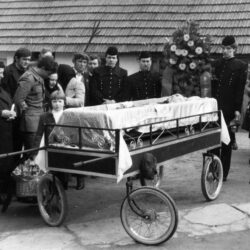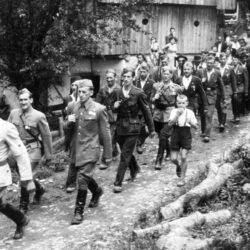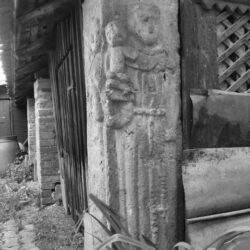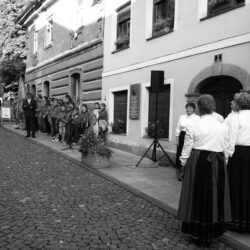They Went to Hear Them Sing: Song Traditions of the Kamnik Area
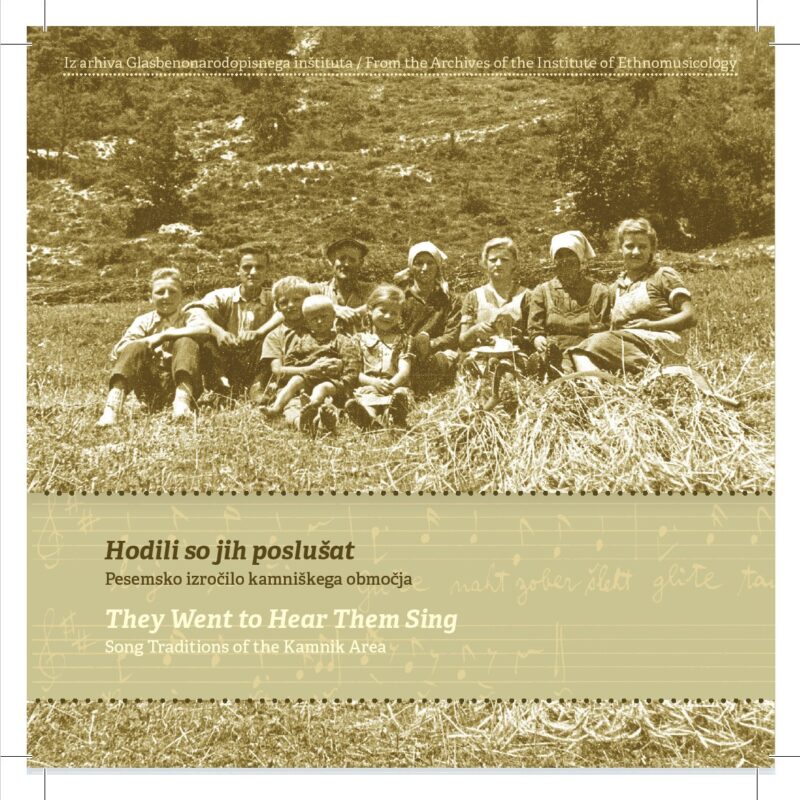
GNI Nevlje, 3. 6. 2016, Gor./1
Recorded: Nevlje, 2016
Bell ringing: France Oražem, parish priest
Until the 1990s, the small bell of the St. George’s church in Nevlje, otherwise used upon death in the village funeral services, would sound every workday at three o’clock in the afternoon to preserve the memory of the disastrous flooding of the Kamnik Lake. It is believed that on that occasion the natural dam connecting Mali and Stari grad, which held the lake back, gave in. While the water flooded through, the bells of the Nevlje church began to ring on their own.
GNI M 23.443
Recorded: Zgornji Tuhinj, 1960
Sung by: Cila Zore, Terezija Zavasnik
A part of the Kamnik area has been historically defined by transport. Local inns had a very important role there, so meeting at the table and drinking has, in some places, remained socially significant, especially in Kamnik and the Tuhinj Valley. Wine was fairly important on other occasions, mainly weddings. This drinking song from Zgornji Tuhinj is toasting not only the drinkers at the table, but also the very act of gathering and listening to the song traditions of the area.
GNI M 24.097
Recorded: Vrhpolje, 1961
Sung by: Jože Uršič, Lojze Uršič
Due to interesting content, narrative songs remained popular long after people had learned to read and write. They presented mythical stories, legends of saints, various personal or family fates, and funny events. Songs telling tragic stories and legends were preserved the longest, as they were sung during wakes. This ballad of a deserted lover, who uses magic to put her unfaithful lover under a spell and kill him, most probably derives from the sediments of Old Slavic traditions. Besides Slovenians, Croatians and Bulgarians are also familiar with the song. From Slovenians it was passed on to the Gottschee Germans in Kočevje (Kumer, 1962). The singers learned the song as children in Stolnik from their grandfather, born in 1847, who always finished the song with a comment about Marjetica: “Mejduš, ta j bva pa kunštna!” (“Bless my soul! She was a shrewd one!”).
GNI M 26.227
Recorded: Otavice pri Ribnici, 1963
Sung by: Štefka Knaus, Frančiška Knaus, Angela Bojc
This mocking song was created by the people living around Kamnik as a joke on the Kamnik burghers. From the content we can deduce the atmosphere at the end of the 18th century, a time at which Kamnik still boasted a city wall and a town hall. In the mid-1800s, when interest in traditions led to the publication of lyrics for the first time, the song stood as an expression of Kamnik’s recognisability. The individual stanzas, depicting different images of life in Kamnik, had no set order, so the written sources differed greatly from each other. At the beginning of the 20th century, a melody was written down in Kamnik area, mostly including a German-Slovenian chorus. The content of this version is significantly reduced and musically the performance is of poor quality, but it is so far the only known audio recording of the song. A chorus has also been preserved, which shows the ties of the song to the štajeriš dance, and also the context of conflict between the people of Kamnik and the people of surrounding villages (cf. Klobčar, 2016).
GNI Kamnik, 3. 6. 2016, Gor./1
Recorded: Kamnik, 2016
Sung by: Tinkara Grilc
This song fragment, about the French and tax collection, originates from the times of the Illyrian Provinces. The attitude towards Napoleon’s army was very negative among ordinary people. However, tax collection generated significant defiance. The French authorities brought about some changes that undermined the traditional order, including civil marriage. The singer learned the song in Stranje as a child, in an environment that preserved a stronger memory of the Turkish invasions than of those of the French; people even kept the objects that the cunning locals had taken from the Turks on one of thwarted Turkish raids of the church of St. Primus and Felician.
GNI M 23.597
Recorded: Črni Vrh, 1960
Sung by: Janez Resnik
A lot of war songs have been preserved in the Tuhinj Valley. Not only those the lads sang when saying goodbye to their girls, but also songs about war and battles, depicting a heroic image of history. The first type of songs were much like love songs preserved through serenading, while the latter songs were sung by men during gatherings at inns. Audio recordings have been made mostly of the farewell songs, sung by lads and preserved the longest. Among them is also Jeno žalostno ptičko sәm slišov snoč pet. As the singer has pointed out, the song was considered a lads’ song.
GNI M 23.928
Recorded: Stahovica, 1960
Sung by: Manca Šlebir, Neža Koželj
In the mid-1900s, older people beneath the Grintovci still liked to sing lively poskočnice songs, women even more often than men. Kamnik and its surroundings belonged to the area of the vocal-instrumental štajeriš (Vodušek, 2003 [1960]: 53). Still, at the time the first recordings of the Institute of Ethnomusicology were being made, only the oldest people were aware of the earliest ties of the poskočnice songs to štajeriš dance. Several dancing song sets or independent four-line stanzas were known, which humorously depicted either the characteristics of other people, or else their own love affairs, or those of other people.
GNI M 23.554
Recorded: Češnjice, 1960
Narrated by: Franc Zore
After young men finished singing in the villages, they went under the windows of girls. While serenading, they helped themselves with rhythmic, spoken-word templates, the so called goats’ prayers. These lyrics were passed from one generation of boys to another and so the girls, instead of hearing gentle declarations of love, were subject to unrefined jokes. Some boys were very skilled, even though they spoke very quickly: “To səm jəh vezov take pod oknam, də je kər ušla” (“I pattered so well, she just ran away”). In this template a boy is trying to convince a girl to get out of bed, or else her skin will become full of holes and will be no good even for a šuštar, a shoemaker.
GNI M 23.751
Recorded: Špitalič, 1960
Sung by: Tone Cencelj, Joža Učakar, Janez Učakar, Miha Učakar, Janez Semprimožnik
The love song Pa bom v Šiško v vas hodiv is notable because of both its singing and its content. The motif of the song points to the fact that boys liked to show off in front of other people. Boasting about having a lover in Šiška, once a suburb of Ljubljana, would improve young men’s reputations, even though the lover existed only in a song. The song preserves memory of times when girls wore long skirts. At that time, girls from Šiška were considered especially attractive, not least because they wore shorter skirts.
GNI M 23.929
Recorded: Stahovica, 1960
Sung by: Manca Šlebir, Neža Koželj
Wedding traditions were very much alive in the mid-20th century, although some elements were no longer used. The memory of these elements was preserved in songs. The song no novo pošto nosim would be sung at weddings at midnight, when the bride’s wreath was taken off her head. Contextually, the beginning of the song ties to the ritual of inviting guests to the wedding.
GNI M 23.706
Recorded: Jastroblje, 1960
Sung by: Ančka Cencelj and a group of singers
The song Prelubi moj prijatu was one of the drinking songs that usually accompanied a wedding, or ohcet. The amount of wine at the wedding was a measure of the groom’s family’s reputation. This is also expressed in songs about wine and in drinking songs. The wedding guests would sing them to encourage each other to drink, as there was enough wine for people to freely drink it.
GNI M 23.565
Recorded: Veliki Hrib, 1960
Sung by: Marija Jeras
The weddings on the richer farms would last two days, or even three before the First World War. Musicians were responsible for the proceedings and the atmosphere at such weddings. Besides toasts and wine songs, the guests were entertained by so-called ohcetne pesmi, the wedding song. These were songs that dealt with weddings in a fun way, often with animals in human roles.
GNI M 23.712
Recorded: Bela pri Motniku, 1960
Sung by: Marija Zajc
The harshness of everyday life meant that mothers were rarely able to sing lullabies. Owners of larger farms could afford young child minders, pestrne, for their babies. And elsewhere this role was often taken on by brothers or sisters who were older, but still too young to work on other farms. Lullabies were therefore rare. So here, not only are song traditions revealed, but the conditions families lived in are too.
GNI M 23.581
Recorded: Veliki Hrib, 1960
Sung by: Marija Jeras, Ivana Dacar, Marija Baloh
While there were not that many lullabies, both adults and children regularly said an evening prayer. Unlike the prayers said by adults, children’s prayers were adapted to their understanding of the world.
GNI M 34.502
Recorded: Pšajnovica, 1973
Sung by: unknown woman
This narrative song about a suicide a nun committed because of love tells a tragic story of a young girl who had to join a convent against her will. It refers to Velesovo Dominican convent where the richest aristocratic families used to send their girls (Hančič, 2005:40). Criticism of some actions connected to the Church may show a tendency towards Protestantism (cf. Golež Kaučič, 1998: 175). However, in the Tuhinj Valley this kind of revolt mostly reverberated in the revolutionary resistance during the Second World War.
GNI M 28.991
Recorded: Brezovica pri Buču, 1968
Sung by: Nežka Zore, Lenčka Zore, Rezka Zore, Angelca Pavlič, Mica Pavlič, Milica Virjant
Protestantism deeply resonated in the Kamnik area. Consequently, at the time of Counter- Reformation and baroque, affiliation to the Catholic Church was more powerfully expressed. Carriers of the Catholic revival emphasized their stance by building new churches, as well as through musical creativity. The latter found its place in traditional songs. The structure of numerous moral-educational songs from this time was based on sermons, as in the song Hvaljen bodi, Jezus Kristus.
GNI M 25.234
Recorded: Gojška planina, 1962
Sung by: Karl Gradišek
The content of poskočnice songs often referred to the relationships between boys and girls, and sometimes also to relationships in the broader framework of social groups, mostly among the people of different villages. Poskočnice songs, with their jovial manner, paint people’s characteristics while indirectly revealing social norms. The song Te tunške dekleta makes fun of the girls from Tunjice. They make their pale, white skin, which was actually a beauty ideal, the butt of the joke, saying that it is a result of avoiding work on the fields.
GNI M 25.191
Recorded: Kališe nad Kamnikom, 1962
Sung by: Janez Dolinšek
Songs provided different communication levels as well as solutions to personal problems. Married men took advantage of this and made fun of their wives’ reigns, although women rarely used songs in quite the same way. They preferred to solve their problems directly. The message of the song Preljubi mož, varuj se svoje žene is very direct. The content depicts a marital quarrel and its echo in the afterlife.
GNI M 23.444
Recorded: Zgornji Tuhinj, 1960
Sung by: Jernej Kadunc, Ivan Drolc
In the period before Shrovetide, people would become worried about their harvest and their family lines. The masks drove winter away, they danced to get big turnips and to take care of weddings. A girl who had a prospect of marriage but remained single was the butt of the joke, regardless of her reasons. On Shrove Tuesday she received a ploh, a sliver taken from a log, which specifically represented the erotic nature of the ridicule. When transporting the ploh and singing the accompanying songs, the whole community would enjoy themselves at the expense of these single girls. The dancing song sung in defense of the girls scolds young men who ignore girls, and women whose behaviour drives men away. The lyrics clearly show the particulars of speech from Tuhinj, e.g. the scolding of boys:
“It is bad to sit in winter at the stove,
For girls, they suffer so.”
GNI M 23.657
Recorded: Jastroblje, 1960
Sung by: Francka Pestotnik
In the Kamnik area, carolling was most alive in the city itself, and in the villages immediately surrounding the city, the carollers being poorer city children. Far away villages were mostly visited by carollers from other places. Carollers from Ihan and Tržič visited the surroundings of Komenda, sometimes on horses, while the Tuhinj Valley was visited by carollers from the Štajerska and Moravče regions. The locals only seldom went carolling, mainly those who were forced to do it by extreme poverty. This carol about the Three Kings from Jastroblje preserves the memory of the koleda, a drama scene that accompanied the carolling.
GNI M 23.958
Recorded: Spodnji Hrib, 1960
Sung by: Marička Spruk, Katarina Spruk, Francka Mali
Similarly to Christmastime, when people remembered the birth of Christ with songs and with a manger in their homes and churches, they would sing either Rosary prayers or the Way of the Cross during Lent in order to feel closer to the suffering of Christ. Lent songs were often intended for wakes. The motifs of songs point to the picturesqueness of the simple representation of theological issues.
GNI M 23.676
Recorded: Jastroblje, 1960
Sung by: Ančka Cencelj
For common people, pilgrimages were the most important diversion from their everyday lives. However, religious fervour was at the forefront. One way in which the leaders of pilgrimages, romarski vojvode, took on the responsibility of conveying the religious message was with pilgrimage songs, which would emphasize personal feelings about religious content.
GNI M 28.955
Recorded: Brezovica pri Buču, 1968
Sung by: Nežka Zore, Lenčka Zore, Rezka Zore, Milica Virjant
This ballad, about a girl who was killed as she was feeding bundles of grain into the threshing machine, proves that fatal events such as this one resonated in the folk creativity well into the first half of the 20th century. The girls from the Tuhinj Valley learned the song before the Second World War, during the harvest of hops in the Savinja Valley.
GNI M 25.202
Recorded: Kališe nad Kamnikom, 1962
Sung by: Ivan Dolinšek
The work of miners, knapi, in Črna’s kaolin mine was backbreaking, and they were constantly exposed to danger (cf. Rifel, 2006: 13 132). The song emphasizes the miners’ low social status and, at the same time, through a brief description of their work expressed in their own jargon, preserves the memory of the miners in the valley.
GNI M 23.534
Recorded: Češnjice, 1960
Sung by: Jože Jeglič, Franc Zore and Francelj Poljanšek
Some partisan songs were very popular in parts of the Tuhinj Valley. They reminded people of the injustices and segregation that had happened to poor people before the Second World War and of the singing in partisan choirs during the war. These songs were being preserved at the anniversaries of events from the National Liberation Struggle, and through school curriculum. Some of them people liked mostly because of their musical expression.
GNI T 117/3
Recorded: Stahovica, 1981
Narrated by: Johana Slevc
People who were deported abroad by the occupying German army during the Second World War tried to find various connections with home, as well as ways out of their hardships. Often it was a song that connected them to their home, while a prayer helped them survive the hardships. Among the people deported to south western Germany a special prayer was popular, which was written on the wall of one of the chapels in Germany by an unknown exiled Slovenian.
GNI M 24.405
Recorded: Brezje pri Kamniku, 1961
Sung by: France Žagar
The prison song Štәrdәsәt nas je restantov conveys the distress of numerous prisoners, from those who were arrested during their military service to those who breached the law as civilians. France Žagar, also called Vožbutov France, learned it when he was imprisoned, with some other recruits, for a fatal fight that happened shortly after a recruitment drive in Kamnik in 1950.
GNI M 25.097
Recorded: Gozd, 1962
Sung by: Kati Turk
This song shows traces of the creativity found in dancing songs, connected to the traditions of people living beneath the Grintovci. Visitors to the mountains came into contact with these traditions and with the amusing depiction of the lives of locals and, after the First World War, they joined the creative effort themselves. It shows the creative power of Janez Gregorin, as well as other mountaineers, locals and shepherds, including Kati Turk. The interweaving of their creativity is a reflection of their co-creation.
GNI M 25.232
Recorded: Gojška planina, 1962
Narrated by: Kati Turk
This flicker of sound from the mountain pastures preserves the memory of a time when Velika, Mala and Gojška planina were just pastures, and the shepherds’ huts still had the traditional oval shape (cf. Cevc, 1972). The shepherds would tell each other stories of wild men and heathen maidens, and of elves in Tiha dolina.
GNI Podgorje, 24. 11. 2011, Gor./4
Recorded: Podgorje, 2011
Sung by: Milan Troger
Workers who moved to Kamnik after the Second World War maintained ties with their hometowns also through songs. This longing is symbolised in the version of the song Jaz sem Drejčev Neče composed by the 19th century itinerant singer Jurij Vodovnik, which moreover expresses hardships of homelessness.
GNI Kamnik, 27. 5. 2012, Gor./1, 2
Recorded: Kamnik, 2012
Sung by: Jože Berlec
St. Anthony of Padua was a well-known saint who people prayed to for a partner, and for luck in love. In the Kamnik suburb of Novi trg there was a chapel dedicated to him. The people of Novi trg would gather on the eve of his name day next to the decorated Tomanovo znamenje to pray and sing. The song O, preljubi svet Anton expressed the recognisability of the suburb. The people of Novi trg continued to gather at the place in front of the former chapel even after it was demolished in the 1960s.
GNI Kamniška Bistrica, 28. 1. 2010, Gor./5
Recorded: Kamniška Bistrica, 2010
Narrated by: Anica Žagar
Up until the Second World War (and in some places, for even longer) the apocryphal prayer, in the form of a narration of the suffering of Jesus (also known as “the golden paternoster”, Kumer, 1999) was said mostly on Fridays, as well as during Lent by some women. The living memory of these prayers in the 21st century is surprising. Recorded in the hamlet of Kopišče, in the proximity of mass graves from the time after the Second World War, this prayer expresses loyalty to tradition as well as awareness of the fatality of these events.
GNI Kostanj, 15. 11. 2013, Gor./8
Recorded: Kostanj, 2013
Sung by: Folk Singers from the Tuhinj Valley (Rok Juhant, Albin Pirš, Peter Juhant, Franc Grošelj, Fortunat Hribernik, Ivan Hribernik, Silvo Osolnik, Peter Osolnik, Janez Pančur, Franc Pančur)
This group of singers from the Tuhinj Valley best presents the vitality of the song traditions of the area. Spontaneous singing has been preserved without external encouragement. One of the singers described this spontaneity with the words: “We sit down and sing.” Singers, otherwise used to choral singing, sing songs they like, among them those that have been preserved through various customs. “Old songs” are sung in the traditional way. The song Dober večer, sung in the name of the deceased, is presented with one example only; during the wake the singers sang their goodbyes to all the family members and the neighbours.
GNI Kamnik, 3. 6. 2016, Gor./5
Recorded: Kamnik, 2016
Sung by: Folk Singers Predice (Angelca Jagodic, Fani Klemenc, Štefka Cerar, Ivanka Kos, Dragica Požek)
The Folk Singers Predice group was founded with the purpose to revive traditional singing in Slovenia. Angelca Jagodic was the one who advocated for the founding of the group the most. The first appearances of the group were connected to the revival of the Budnar house in Zgornje Palovče. The group selects the songs for their repertoire focusing on traditions, some of which are brought by singers from their local environment, while others are found elsewhere, even in other groups. Jože Jagodic, an accordion player, has been collaborating with the group from the beginning. Their appearances in Kamnik and the surrounding area accompany certain public events and private celebrations, therefore helping shape contemporary perceptions of folk traditions.
GNI Spodnje Stranje, 3. 6. 2016, Gor./2
Recorded: Spodnje Stranje, 2016
Sung by: Ana Plahutnik, Manca Plahutnik
Played by: Tomaž Plahutnik (zither), Ana Plahutnik (guitar)
The singing of these young girls, accompanied by the zither and the guitar, resonates the perception of the folk as typified by the Kamnik Carollers at the time of Slovenian independence. At the same time it is an expression of the power of family traditions and of the effort to create clean harmonies. The song Po vodi plava itself suggest a love theme and as such lives in the representation world of the young. Placing the song in the Kamnik area creates a connection with the image that has lived in tradition through centuries – the image of Kamnik Lake.
Marija Klobčar: They Went to Hear Them Sing … Discovering Soundscapes of the Kamnik Area
This audio publication, named after a memory of singing from time long past, reveals soundscapes of the area under the Kamnik-Savinja Alps – the mountain pastures, the broad meadows by the Kamniška Bistrica river, the Tuhinj Valley, and the hills on the outskirts of Kamnik. These soundscapes reflected both the personal hardships and the joys of individuals, as well as the life of a whole community. They resounded with ancient traditions and with modernity, for these soundscapes have changed as life itself has changed. They have combined soundscapes of the known and the unknown, the domestic and the foreign, the constant and the transient; often written only into the fleetness of memory.
It is a memory of sound – invisible, intangible and often elusive – that, in the Kamnik area, reaches far into the past. It takes us to the locals, who shepherded animals on the mountain in summer, and would tell stories of the mysterious inhabitants of remote places; of wild men (dovji možje) and of heathen maidens (ajdovske deklice), revealing the experiences of our ancestors. It is a memory of tradition tied to the image of the heathen maidens that was present from Krvavec to Menina planina, which conveys the soundscape of a distant experience. In the evening the shepherds on Velika Planina lit fires on the stone hearths of their cottages, then went to the edge of the known world and waited to hear the heathen maidens sing. The memory of the magic of their singing was preserved until the time the cableways began operating on Velika Planina: “They really knew how to sing! They sang after sundown, the shepherds went to hear them sing.” (Cevc, 1972: 65)
In the same way that the singing of the heathen maidens summoned the locals, the shepherds’ and lumberjacks’ traditions captivated mountaineers discovering the beauty of Grintovci during the period between the two world wars. It was the shepherds’ heritage that prompted immense interest in the Kamnik area after the Second World War. By the end of 1950s, researchers at the Institute of Ethnomusicology in Ljubljana – with the help of the custodian of the heritage of Velika Planina, Vlasto Kopač – stepped into this world, tape recorders in hand. They shared a fascination with the unique material culture and, captivated as they were by the singing of the local people, an excitement for these song traditions (Kopač, 2003: 17).
However, even before that, the researchers of the Institute of Ethnomusicology had been drawn into recording the song traditions of another region, the Tuhinj Valley. Their co-worker, Marija Šuštar, brought them to the place of her childhood. The songs recorded at the end of the 1950s and the beginning of the 1960s in the area of the so-called “Tuhinj speech” reveal clear traces of encounters of two cultural traditions through the recognisable characteristics of the dialect, interpreted as an expression of isolation (ex. Logar. 1954: 150–155) or as a trace of immigration to this area (Hrovat, 1864:19–20; Klobčar, 2016: 49, 99, 260).
The early recordings preserved in the Institute’s archives predominantly reflect two worlds: that beneath the mountains, and that of the vast soundscapes of the people of the Tuhinj Valley, who were defined by their resistance during the Second World War. The specific characteristics of the mountain world mostly echo in their love songs, which often feature poskočnice, a type of lively songs. The love described in these songs frequently occurred outside marriage, and was often the one thing that enriched the world of poor day labourers beneath the Grintovci. These people mainly respected the laws of the mountains, reigned over by the white chamois. Most of them still believed that breaking these laws could result in death, as happened to King Aleksander the 1st Karadžordžević, who died in 1934 soon after killing a white chamois in Kamniška Bistrica under Črni vrh (ex. Cevc, 1973: 95).
On the other hand, the people in the remote area of the Tuhinj Valley were defined in quite a different way by a burden of laws and customs. The preservation of rich wedding customs had brought with it the memory of an ancient law: the right of a landlord to take a bride on her wedding night whenever there was a wedding among his subjects in a village. This right also burdened the memory of the people later, when they merely had to obtain final permission for the wedding from the landlord. The song tradition (being very much dependent on the power of the Church) remained integrated into the customs that defined the community, not only at weddings but also at the deaths of their fellow villagers. At the same time, their world was still accessible enough to accept both secular and religious stories poured into songs. Because of that, narrative songs have been preserved in this area, even as they have disappeared elsewhere.
Between these two worlds and also next to them lies not only an expanse of hills, which spread into a plain near Kamnik, but also many varied, hidden places of tradition, caught between past transport routes and remote places. The Institute’s associates discovered these worlds on planned field recording trips, which were often connected with the name of a shepherd, singer and creator Kati Turk. These recordings gave shape to other images of tradition. From those of the miners in the kaolin mine in Črna, through memories of pilgrimages and of the Second World War, to reactions to current events, the heritage of lads’ singing, and songs that were born from direct contacts with the city of Kamnik. Some of these were caught by our microphones, others eluded this fate as for example, the song of the workers who repaired dams on the Kamniška Bistrica river. A forgotten German song that gave workers the rhythm to which they hammered stakes into the riverbed, and which today is but a mere gossamer of memory.
It has been possible though to start unveiling this memory even decades later. Following soundscapes up to the present day, as on the audio publication, not only illustrates the fact that a past tradition is still alive today, but also presents an opportunity to discover images that were not of interest to folklorists some decades ago. This unveiling took place as part of my comprehensive research, connected to the monograph Na poti v Kamnik (On the Way to Kamnik, Klobčar, 2016). The purpose of the research was to reveal life in the Kamnik area over the last two hundred years, focusing on the recognition of social diversity, on the observation of the relationship between the city and its surroundings, and on following the reflections of this life found in the area’s traditional culture. It revealed some images of song traditions that had remained unnoticed before and, at the same time, its findings have enabled us to better understand the older material from the Kamnik area and the various paths its soundscape has taken through time.
On the audio publication this world introduces itself with images that go the furthest into the past. The journey into the distant memory starts with the bell ringing of St. George’s church in Nevlje, a memory of the flooding of the Kamnik, or Nevlje, lake. After a kind invitation to listen, the sound of the bell is followed by a ballad which gives a glimpse into the imagery of Old Slavic traditions. It originates from the area immediately surrounding Kamnik, which also shows that narrative songs, that is songs conveying stories, were widespread in the urban environment in the 19th century. This auditory walk into history is rounded off by a mocking song about Kamnik burghers, a soldier song and a short, sung fragment from the time of the Illyrian Provinces.
These semantic cues delineate the basic features of space that fills the soundscape of the audio publication. The soundscape, with the selected song reflections of different images of village life, be they of daily routine or of a celebration, reveals either the standing of an individual or of a community. Rituals linked to an individual’s life were punctuated by wedding songs. The everyday of adults is revealed in the songs people sang at a gathering, when working together, or at a wake. On these occasions narrative traditional songs were most often heard. Due to limited space, the audio publication presents these songs only briefly.
For the same reasons it was necessary to be very selective with other songs as well: these are selected examples of mocking songs, short prayers, songs sung on pilgrimages or in special circumstances, also for example in prison, and songs sung in solitude. Some songs echo lads’ singing, which was, at the time of the first recordings, still alive in certain parts of the Kamnik area. These glimmers of sound, stretching from the time of courtship to the mere memory of it, provide the audio publication with the most recognizable singing of the people from under the mountains: the singing of lively poskočnice songs.
The singing on the audio publication includes people who learned the songs singing at home, with their peers while shepherding animals, in the company of boys and girls, or among adults. They also learned the songs at school, at the church, at events or in various associations. The songs learned at home were mostly sung “in the old way”: the middle was the leading voice, the voice of a singer who “sang ahead” while other voices accompanied it. The songs people learned elsewhere were sung differently, with the voices following the choral type of singing. This audio publication aims to emphasize singing po starem, in the old way, while also presenting changes, despite the fact that the fairly limited space on the audio publication meant we could only select the most representative recordings.
The audio publication connects song memory with the present vitality of the song traditions in the consciousness of the people of Kamnik and its surroundings. This imagery, built through recording song traditions in the Kamnik area since the mid-19th century (Klobčar, 2016: 63–78), has been created by individuals and groups over the last few decades. This revival of traditions followed examples from elsewhere and certain events, such as the Days of National Costumes and Clothing Heritage, and professional incentives. At the same time, traditional singing has been preserved as a personal memory for some individuals; as part of family traditions, existing independently from the eye of the profession. New songs have joined these traditions, from the world of popular music or pop folk music and klapa a cappella singing, and together with pop folk tunes have generated a new world of the folk.
The audio publication cannot feature new songs that entered the folklore and due to limited space it does not include instrumental music either. The series of songs therefore presents mostly the soundscape of the past and connects it to the contemporary life of the song traditions. The timeline is not entirely linear as contextual similarities between the songs have been taken into account. Still, it does span from the echoes of the distant past to the soundscapes unveiled from the memory of individual singers. The songs preserved in the Institute’s archives as well as the modern imagery of traditional songs draw us to the listening. Not just in the way ancient heathen maidens drew the shepherds, but with the awareness defined by the worth of our own past.

